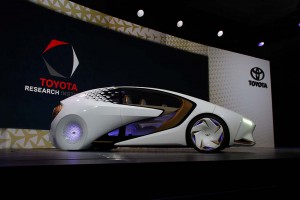
Gill Pratt heads up Toyota's autonomous vehicle program. He believes it will take longer than current estimates to produce viable self-driving vehicles.
Autonomous vehicles have gone from science fiction to everyday reality, or so one might think, listening to the many automotive news conferences at this year’s CES event in Las Vegas.
Hyundai’s vice chairman Eui-sin Chung arrived at his event at the Mandalay Bay Resort in an autonomous Ioniq prototype, reading over his notes along the way. Start-up Faraday Future unveiled its new FF91 battery-car by having it park, and later drive onto the stage, with no one in the vehicle at all.
Yet, even as more and more autonomous prototypes start testing on public roads, a few skeptical voices can be heard, notably including Gill Pratt, an early pioneer in autonomous technology and now head of the Toyota Research Institute, the recently formed unit charged with overseeing Toyota’s self-driving development program.
It’s going to take far longer than many proponents are claiming to get to full, go-anywhere/anytime autonomy, Pratt said during Toyota news conference at CES, and even longer to reach the point when there’ll be no driver at all.
That he stressed, “is a wonderful goal. None of us are even close.”
A number of automakers likely will be selling autonomous vehicles on the retail market “over the next 10 years,” Pratt said,” but they are going to require a trained “operator” to sit behind the wheel ready to take over at a moment’s notice in the event something goes wrong.
(Toyota tries to humanize auto tech with Concept-i. Click Here for the story.)
The industry has segmented autonomous technology into five “levels:”
- Level 1 vehicles are already commonplace and are equipped with technologies like electronic stability control that step in when a car begins to skid, for example, but the driver maintains hands on the wheel at all times;
- Level 2 vehicles, such as those with Tesla’s Autopilot, can permit brief periods of hands-off driving in very specific situations, but “the driver must always be ready to take control” at a moment’s notice, said Pratt;
- Level 3 vehicles operate hands-free for longer periods and under broader conditions, and the driver may get more warning before having to retake control;
- Level 4 is where operators largely can set back, watch a video, take a nap and effectively become just another passenger – though in select locations and situations, such vehicles may need to be operated manually in the most dense traffic or in some other situations;
- Level 5 vehicles operate autonomously, even as driverless vehicles, under any and all circumstances.
Level 5 will remain a major challenge for years, perhaps even decades, warned Pratt. One reason is that it will be a challenge to pack all the necessary processing power into a vehicle – and to come up with enough electric power and cooling capabilities. As sophisticated as the latest microprocessors have become, they struggle to handle the challenge of driving in dense traffic and bad weather as well as humans, “and they are far less efficient” from an energy standpoint.
“Electrical power may be one of the limiting factors,” he told TheDetroitBureau.com. “One of the hurdles we have to overcome is that computers are not as efficient as our brains.”
Each level of autonomy has its own challenges, Pratt noted. With Level 2 and 3 vehicles, humans will need to remain behind the wheel, but they will also need to be ready to drop whatever else they might be doing in order to focus on the task of driving within seconds. Consider, he noted, that at 60 mph, a vehicle will travel more than a quarter mile – the length of three football fields – in just 15 seconds.
“The challenge is how long the human driver will need to disengage from texting or reading,” Pratt said, noting that studies have shown the longer a vehicle has traveled without needing human intervention, the longer it will take that operator to respond if there is an issue.
(Click Here for more about how the connected car industry will grow to $130B by 2019.)
That may mean that automakers will really have to focus on developing Level 4 systems that would rarely, if ever, need human intervention. But they would also be able to operate autonomously only in select, “geo-fenced” areas. And they may have to either pull over or go back to manual mode in some situations, such as a heavy rain or snow storm.
“We have to ensure there’s a fallback,” said Pratt.
But he does believe the industry will get there, even if it takes longer than expected. “I believe a number of manufacturers are going to be out with Level 4 systems within the next decade,” Pratt said, adding, “I believe (Toyota) is one of them.”
There is another issue that the industry will have to address before bringing autonomous vehicles into mass production, Pratt concluded, cybersecurity. It’s something “we worry about all the time.”
In fact, Mark Rosekind, the outgoing administrator of the National Highway Traffic Safety Administration, has called cybersecurity perhaps the single-biggest issue the auto industry faces. Unless automakers and suppliers can figure a way to lock hackers out, all sorts of advanced vehicle technologies – not just autonomous driving systems – will be at risk.
(Autonomous cars, battery vehicles and record sales: a look at 2016′s top stories. For more, Click Here.)
Industry researchers are exploring a variety of different approaches to keeping hackers out, but the challenge is severe and could prove difficult to overcome.


